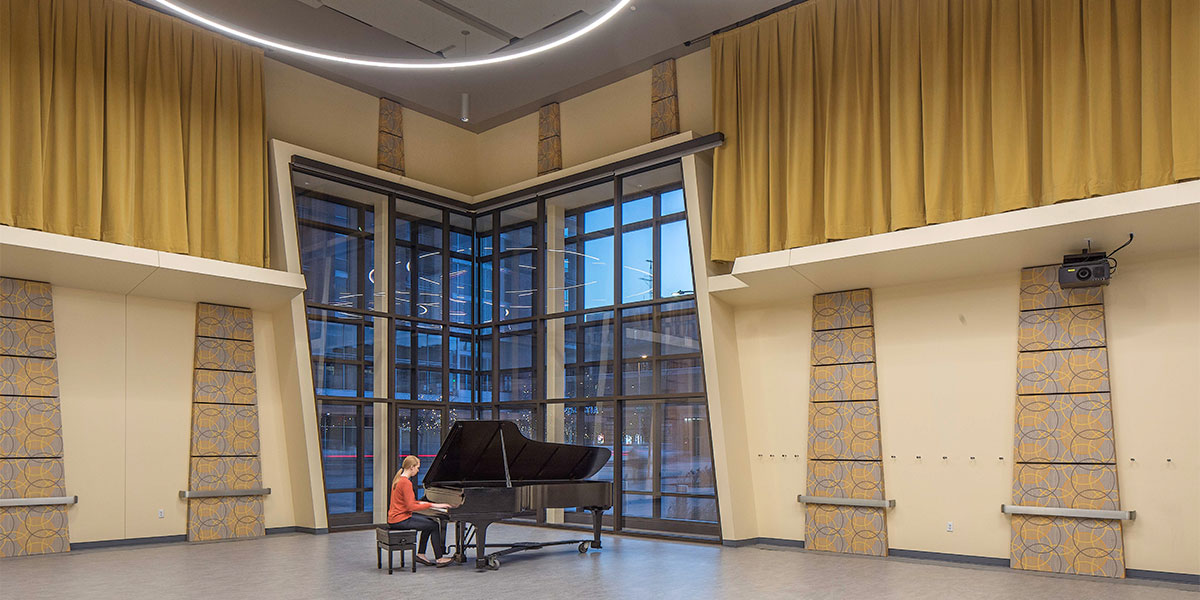This project was designed in partnership with Steinberg Hart
Awards
AIA Wisconsin Award of Merit
2022
PCI Design Awards
Best Theater Building
2022
PCI Design Awards
Theaters Honorable Mention
2021
LEED Certification
2020
ACEC National Honor Award
2020
Engineering-News-Record Midwest’s Best Cultural Project
2020
Objective:
Multifunctional and Flexible
The 63,300-SF Hamel Music Center on the UW-Madison campus was created to serve as an anchor of the East Campus Arts Gateway and as a showcase for the Mead-Witter School of Music. The Mead-Witter School of Music is ranked in the top 5 percent of public schools of music in the U.S. and has earned international stature. By engaging the public through over 350 performances and events each year—from symphony and chamber orchestras to soloists and choral performers—it’s true that (after sports) the music program serves as the main public face for the university.
“I’ve been nothing but pleased with Strang’s meticulous attention to the details and mission of our complicated performing arts project.”
Susan C. Cook, Director, UW-Madison Mead Witter School of Music
SOLUTION:
Frozen in Time
The venue, created by Strang in conjunction with Steinberg Hart, includes a 315-seat recital hall, large rehearsal room, and spacious lobby. Designed to spotlight the breadth, power, and purpose of musical exploration, this new facility elevates the program to the highest levels of collegiate music education.
As Johann Wolfgang von Goethe wrote, “Architecture is frozen music.” The folded, faceted forms of the precast panels evoke the imagery of flowing stage curtains frozen in time. In fact, one of the major themes of the building, is objects frozen in time. The interior scheme is inspired by Wisconsin’s landscapes: deep blues reflect our lakes while plum, gold, and maroon are the colors of our state tree, the sugar maple, in various stages of transformation. The Hamel Music Center is designed to evoke the musical experience as one experiences architecture through time. The exterior curtain wall façade of the main entrance invites the public to “enter the sheet music”.
Acoustic Concerns
The scheme for the building required unique approaches to acoustical challenges. Rather than burying the performance venue in the core of the building, the Collins recital hall was placed prominently right at the busy intersection. Fully isolated double wall construction, which incorporates the iconic folded precast concrete panels, accommodates this placement with total acoustic isolation.
The main concert hall also features a unique approach to acoustics, although in a more subtle way. Flanking the hall, acoustical reverberation chambers allow the venue to sound much larger than its physical volume would suggest. These chambers, four stories tall made of solid concrete, also contain acoustical curtains, which allow them to be uniquely tuned. The space is totally customizable based on the particular needs of each performance. These reverberation chambers, while not directly visible from within the performance space, are represented by large circular penetrations in the shell of the side walls. These forms are representative of the sound holes that allow reverberation and projection of sound in many string instruments, like a guitar.

A Shift in Convention
Lastly, opposite from the recital hall, in full view of University Avenue, the main rehearsal space is prominently featured as an iconic element of the building. Featuring the rehearsal space so publicly is unconventional; generally, artists are only showcased during performances, while their preparation remains unseen. Here, the preparation is on full display, framed perfectly for view by the isolated double-curtain-wall construction at the sidewalk level for any passerby’s to see.













